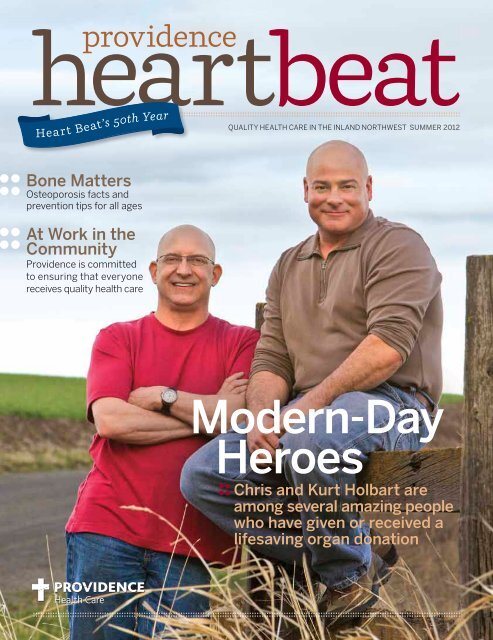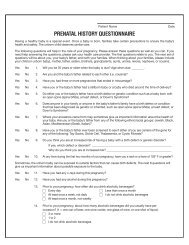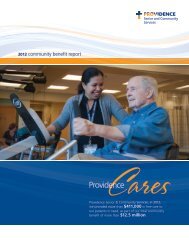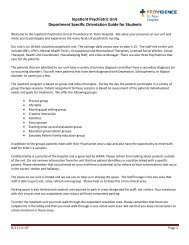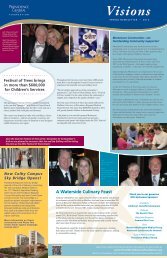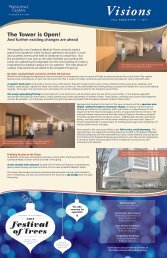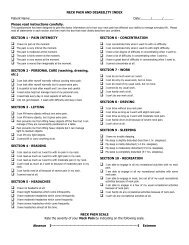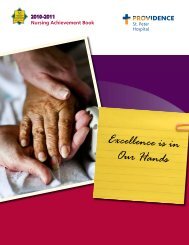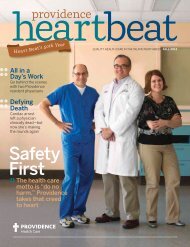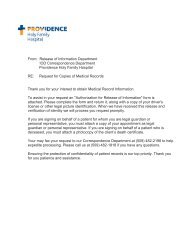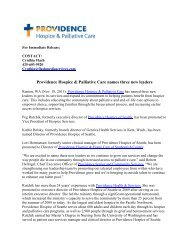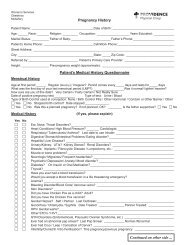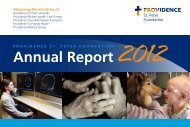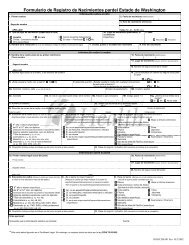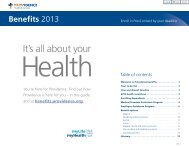Issue 2 - Summer - Providence Washington - Providence Health ...
Issue 2 - Summer - Providence Washington - Providence Health ...
Issue 2 - Summer - Providence Washington - Providence Health ...
Create successful ePaper yourself
Turn your PDF publications into a flip-book with our unique Google optimized e-Paper software.
heartbeat<br />
providence<br />
Quality health care in the Inland Northwest <strong>Summer</strong> 2012<br />
Heart Beat’s 50th Year<br />
Bone Matters<br />
Osteoporosis facts and<br />
prevention tips for all ages<br />
At Work in the<br />
Community<br />
<strong>Providence</strong> is committed<br />
to ensuring that everyone<br />
receives quality health care<br />
Modern-Day<br />
Heroes<br />
Chris and Kurt Holbart are<br />
among several amazing people<br />
who have given or received a<br />
lifesaving organ donation
Jeff Philipps, CEO<br />
Rosauers Supermarkets<br />
<strong>Providence</strong> <strong>Health</strong> Care Foundation<br />
Board of Directors<br />
WHY DO I<br />
GIVE?<br />
Rosauers has a passion for improving the<br />
quality of life in our community. Our gifts<br />
to <strong>Providence</strong> <strong>Health</strong> Care Foundation<br />
help ensure world-class health care right<br />
here in Spokane, and provide access to<br />
medical treatment for all – especially our<br />
poor and most vulnerable.<br />
phc.org<br />
509.474.4917<br />
<strong>Providence</strong> Sacred Heart Medical Center | Sacred Heart Children’s Hospital | <strong>Providence</strong> Holy Family Hospital
providence<br />
heartbeat<br />
Executive Editor<br />
Joe Robb<br />
Medical Editor<br />
Jeff Collins, MD<br />
Art Director<br />
Monya Mollohan<br />
Managing Editor<br />
Kate Vanskike<br />
Senior Content Editor<br />
Kari Redfield<br />
Photographers<br />
Gary Matoso<br />
Steven Navratil<br />
Copyright 2012 © <strong>Providence</strong> <strong>Health</strong> Care.<br />
Online at phc.org. Published three times a year<br />
by McMurry. Send comments to heartbeat@<br />
providence.org or Public Relations, P.O. Box<br />
2555, Spokane, WA 99220.<br />
Michael Wilson, Chief Executive<br />
Board of Directors<br />
Mike Reilly, Chair<br />
Gary Livingston, PhD, Vice Chair<br />
Marian Durkin, Secretary-Treasurer<br />
Patricia Butterfield, PhD<br />
Ramon Canto, MD<br />
Dan Dionne, MD<br />
Susanne Hartung, SP<br />
Elaine Hoskin<br />
Paul Larsen, MD<br />
Keith Marton, MD<br />
Dean Martz, MD<br />
Rob McCann, PhD<br />
Sr. Judith Nilles, OP<br />
Paul Pimentel<br />
Curt Shoemaker<br />
Phil Stalp<br />
Jim Watts, MD<br />
Ron Wells<br />
<strong>Providence</strong> <strong>Health</strong> Care Eastern <strong>Washington</strong><br />
(PHC) is the parent organization of a number<br />
of Catholic health care ministries sponsored by<br />
the Sisters of <strong>Providence</strong> and the Dominican<br />
Sisters in Spokane and Stevens counties. These<br />
ministries include:<br />
Hospitals<br />
<strong>Providence</strong> Sacred Heart Medical Center<br />
Sacred Heart Children’s Hospital<br />
<strong>Providence</strong> Holy Family Hospital<br />
<strong>Providence</strong> Mount Carmel Hospital (Colville)<br />
<strong>Providence</strong> St. Joseph’s Hospital (Chewelah)<br />
Other <strong>Health</strong> Services<br />
Pathology Associates Medical Laboratories<br />
<strong>Providence</strong> Adult Day <strong>Health</strong><br />
<strong>Providence</strong> DominiCare (Chewelah)<br />
<strong>Providence</strong> Emilie Court Assisted Living<br />
<strong>Providence</strong> Medical Group<br />
<strong>Providence</strong> St. Joseph Care Center &<br />
Transitional Care Unit<br />
<strong>Providence</strong> VNA Home <strong>Health</strong><br />
PHC is part of the <strong>Providence</strong> <strong>Health</strong> & Services<br />
health care system, which spans five states<br />
from Alaska to California and east to Montana.<br />
For more details, visit phc.org.<br />
Mission Statement<br />
As people of <strong>Providence</strong>, we reveal God’s love<br />
for all, especially the poor and vulnerable,<br />
through our compassionate service.<br />
{FROM THE HEART}<br />
Welcoming a New<br />
Medical School<br />
For decades, Spokane has been<br />
a major medical hub for the<br />
Inland Northwest, drawing<br />
patients from across a four-state region.<br />
As far back as the 1960s, <strong>Providence</strong><br />
Sacred Heart Medical Center’s kidney<br />
and heart programs helped put Spokane<br />
on the map for specialized medical<br />
care and have continued to offer<br />
services often found only in university<br />
hospital settings. Spokane physicians<br />
have been actively engaged in medical<br />
research for years, making a name for<br />
our city as a leader in the field.<br />
Over the years, many students<br />
completing their medical education<br />
through the University of <strong>Washington</strong>’s<br />
School of Medicine have come<br />
through Spokane to do their first-year<br />
or third-year residency training at<br />
Sacred Heart and other local hospitals.<br />
Through the program, they gained<br />
valuable hands-on experience, working<br />
beside our experienced physicians.<br />
But … most move on to other cities<br />
outside the Inland Northwest to finish<br />
their residencies and start their careers.<br />
That’s where Spokane has missed<br />
out, and that’s why <strong>Providence</strong> <strong>Health</strong><br />
Care is actively supporting the development<br />
of a new four-year medical<br />
school right here in Spokane. Called the<br />
Academic <strong>Health</strong> Science Center at Riverpoint,<br />
the school will allow students to stay<br />
in Spokane for all four years of their medical<br />
training and will accommodate additional<br />
students each year. Centralized on one campus<br />
in the heart of downtown Spokane, the<br />
new <strong>Health</strong> Science Center will include the<br />
<strong>Washington</strong> State University (WSU) nursing<br />
and pharmacy colleges, the University of<br />
<strong>Washington</strong> School of Medicine and all the<br />
allied health programs offered by both WSU<br />
and Eastern <strong>Washington</strong> University.<br />
<strong>Providence</strong> Sacred Heart Medical Center<br />
is positioned to be the academic hospital for<br />
the medical school offering comprehensive<br />
training and mentoring, and we couldn’t<br />
be more excited about it. <strong>Providence</strong> is also<br />
taking a lead in supporting the capital campaign<br />
for the school because we believe an<br />
investment in the medical providers of the<br />
future is paramount to the health and wellbeing<br />
of our region.<br />
The Academic <strong>Health</strong> Science Center<br />
will not only create jobs and attract people<br />
to Spokane—it will allow new physicians to<br />
complete their education and begin their<br />
health care careers here, too. I believe this<br />
is one of the most important expansions to<br />
occur in our region for many years, and I<br />
am excited about the many positive ways it<br />
will affect our health care delivery system<br />
as we all work together to improve access<br />
to care and enhance the overall health for<br />
the citizens of the Inland Northwest.<br />
You can learn more about this new project<br />
at morethanamedicalschool.com.<br />
Sincerely,<br />
Michael D. Wilson<br />
Chief Executive<br />
The <strong>Providence</strong> Vision<br />
Together, we answer the call of every<br />
person we serve: Know me, care for<br />
me, ease my way.<br />
Core Values<br />
Respect • Compassion • Justice<br />
Excellence • Stewardship<br />
PHOTOGRAPH BY ERIC CHAMBERLAIN<br />
<strong>Summer</strong> 2012 Heart Beat ● 3
{contents}<br />
SUMMER 2012, Volume 50, No. 2<br />
On the cover: Chris Holbart received a<br />
lifesaving kidney from brother Kurt. Read about<br />
Kurt and other generous heroes involved in organ<br />
donation on page 18. Photo by Gary Matoso.<br />
31<br />
3 From the Heart<br />
Spokane is getting a four-year medical school, and <strong>Providence</strong> is proud to<br />
support the effort. Hear more from Michael Wilson, chief executive.<br />
5 Mailbag<br />
A happy reader tells of her new life at <strong>Providence</strong> Emilie Court.<br />
6 Insider<br />
Find out about a special room for parents who are grieving the loss of a baby<br />
and learn how <strong>Providence</strong> is expanding with urgent care centers and clinics.<br />
6<br />
8 <strong>Health</strong>y Living<br />
Enjoy some delicious chicken pita pockets this summer on a picnic, and<br />
employ these tips to avoid common summer accidents.<br />
14<br />
24<br />
10 Children’s <strong>Health</strong><br />
Safety first: Take these five steps to keep your children safe all year-round.<br />
12 Cardiac report<br />
Use this maintenance guide so you can keep your ticker running smoothly.<br />
14 These Bones Are Made for Walking<br />
Osteoporosis is preventable in many cases. Know the signs, and use<br />
these tips to keep your skeletal system healthy at any age.<br />
18 Heroes Among Us<br />
Discover how an organ donation can change families’ lives forever.<br />
These uplifting stories feature people who have given the ultimate gift<br />
of life.<br />
24 Making a Difference and Saving Lives<br />
<strong>Providence</strong> <strong>Health</strong> Care’s commitment to helping those in need<br />
provides lifesaving care to countless people all across the region.<br />
27 HISTORY<br />
Heart Beat celebrates its 50th anniversary.<br />
5<br />
18<br />
28 PEOPLE<br />
Who are the Board of Directors? Find out how these servants guide health<br />
care and make decisions that benefit you and your loved ones.<br />
30 MD spotlight<br />
R. Kim Hartwig, MD, talks about changes in medical practice.<br />
31 Community calendar<br />
Local events, activities, classes and special support groups.<br />
10<br />
32 Role Model<br />
A Lifetime of Healing: Learn how Arch Logan, MD, has spent his life<br />
caring for the poor in the most compassionate way.<br />
4 ●<strong>Summer</strong> 2012 Heart Beat
{mailbag}<br />
Helping Hands<br />
Dear Heart Beat:<br />
I recently made a very difficult decision to give up my home and my two dogs<br />
Sugar and Lulu to move into <strong>Providence</strong> Emilie Court. It was a decision that<br />
I put off way too long. Most people my age have children and grandchildren<br />
to count on; however, both of my children have met with untimely deaths so<br />
I had no one to count on. Fortunately, God provides! A dear family who lived<br />
nearby located the perfect place for me and gently encouraged me for more<br />
than a year. As my health began to deteriorate, I finally moved.<br />
When I arrived at <strong>Providence</strong> Emilie Court, I was so frail and had lost<br />
so much weight that I had to depend on the nursing staff to help me with all<br />
of my personal care. The staff went out of their way to make sure my needs<br />
were met from the first day I moved in. They got me up and dressed me every<br />
morning and encouraged me to eat three balanced meals daily in the dining<br />
room where I was able to meet new friends. I started getting out of my apartment<br />
and enjoying activities regularly, which has helped my social life to<br />
grow and become more diverse.<br />
Moving to <strong>Providence</strong> Emilie Court has been the best decision I ever<br />
made. I have put on weight for the first time in years and have gained<br />
enough strength to feel more confident and in control of my life.—V. Gervais<br />
We’re so happy Ms. Gervais found a home—and friends—at Emilie Court!<br />
Want to learn more about <strong>Providence</strong>’s assisted living facility on the Sacred<br />
Heart campus? Visit phc.org or call 509-474-2550.<br />
facebook.com/<strong>Providence</strong>SacredHeart<br />
facebook.com/<strong>Providence</strong>HolyFamilyHospital<br />
youtube.com/<strong>Providence</strong>Spokane<br />
twitter.com/<strong>Providence</strong>_PHC<br />
TAke OUR Poll<br />
who gets the<br />
most attention?<br />
Regarding health care, whose needs<br />
are you most concerned about?<br />
A) Your own. After all, if you’re not well,<br />
you can’t be sure everyone else is well.<br />
B) Your kids. They’re most apt to bring<br />
home the germs and are most accident<br />
prone.<br />
C) Your aging parents. You worry about<br />
their risks for so many different things.<br />
D) No one. I don’t think about health care<br />
until there’s a need for it.<br />
Visit phc.org/<br />
heartbeat or capture<br />
this image on your<br />
smartphone and tell<br />
us what you think!<br />
Readers Respond<br />
The Spring issue of Heart Beat asked: “When you think of <strong>Providence</strong><br />
hospitals being Catholic, what comes to mind?” Half of the respondents<br />
said “whether a hospital is Catholic has no bearing on my decision<br />
about where to receive care.” For the rest, however, being a Catholic<br />
hospital mattered a great deal, with nearly half of the total respondents<br />
saying that Catholic hospitals care for the whole person or ensure that<br />
all people receive care. See page 25 to learn more about what it means<br />
to be a Catholic health care system.<br />
Want to receive<br />
Heart Beat via email?<br />
It’s easy. Just email heartbeat@<br />
providence.org with “e-magazine<br />
sign-up” as your subject line.<br />
<strong>Summer</strong> 2012 Heart Beat ● 5
{insider}<br />
Where<br />
Angels<br />
Gather<br />
6 ● <strong>Summer</strong> 2012 Heart Beat<br />
Thanks to the generous support of<br />
donors to the <strong>Providence</strong> <strong>Health</strong><br />
Care Foundation, caregivers overseeing<br />
the Forget-Me-Not perinatal<br />
bereavement program at Sacred<br />
Heart Medical Center received<br />
$17,000 to convert a storage area<br />
into a comforting, sacred place. In<br />
what they’ve dubbed The Angel<br />
Room, parents can spend some<br />
uninterrupted time with their baby.<br />
Sacred Heart’s Forget-Me-Not<br />
program cares for an average of<br />
60 families per year who are mourning<br />
the early passing of an infant.<br />
Staff members offer to arrange<br />
photography and to make other<br />
keepsakes, such as plaster molds<br />
of baby’s feet, knowing that these<br />
make a difference to the families.<br />
“I am grateful we have a<br />
new Angel Room for our families,”<br />
says Carolyn Ringo, perinatal<br />
bereavement coordinator at Sacred<br />
Heart. “It’s wonderful to offer such a<br />
beautiful space for parents to be with<br />
their baby at a very difficult time.”<br />
Be Part of<br />
Something<br />
Beautiful<br />
You can help. To learn<br />
more about supporting<br />
services and programs at<br />
<strong>Providence</strong>, visit phc.org<br />
and select “Giving.”
Expanding Care<br />
to the Community<br />
True to its promise to provide<br />
medical care in the most costeffective<br />
manner possible,<br />
<strong>Providence</strong> <strong>Health</strong> Care has announced<br />
the opening of several new outpatient<br />
facilities in the Spokane region.<br />
“The hospital is no longer the center<br />
of the health care delivery system,”<br />
says Michael Wilson, chief executive of<br />
<strong>Providence</strong> ministries in Spokane and<br />
Stevens counties. “To help patients experience<br />
quality care in the most affordable<br />
setting close to where they live and<br />
work, it’s vital to provide more convenient<br />
clinics outside the hospital setting,<br />
and in a variety of locations. This is<br />
central to our vision to answer the call<br />
of those we serve to ‘Know Me, Care for<br />
Me, Ease My Way.’ ”<br />
<strong>Providence</strong> Urgent<br />
Care–Hawthorne<br />
551 E. Hawthorne at Newport Highway<br />
Hours: 8 a.m.–8 p.m. Monday-Friday<br />
and 9 a.m.–6 p.m. weekends.<br />
Services: Routine urgent care, including<br />
lab and X-ray imaging.<br />
<strong>Providence</strong> Urgent Care–<br />
5th & Division<br />
(Coming January 2013!)<br />
421 S. Division<br />
Hours: 24 hours a day, seven days a week.<br />
Services: Urgent care, X-ray imaging,<br />
lab, ultrasound and more.<br />
<strong>Providence</strong> Valley Outpatient<br />
Center (Coming in 2014!)<br />
I-90 at Sullivan<br />
Much more than an urgent care facility,<br />
this multispecialty ambulatory care center<br />
will house “everything except inpatient<br />
beds,” says Wilson. Patients will<br />
have access to outpatient surgery, cancer<br />
treatment, a wide range of imaging services,<br />
short-stay observation and sameday<br />
care from a variety of specialists.<br />
<strong>Providence</strong> is investing $44 million in<br />
this new facility to serve Valley residents<br />
and neighboring communities.<br />
Partnering with Group<br />
<strong>Health</strong> Cooperative<br />
The outpatient expansion efforts<br />
mentioned above are enhanced<br />
through a clinical affiliation between<br />
<strong>Providence</strong> <strong>Health</strong> Care and Group<br />
<strong>Health</strong> physicians. “Both of our<br />
organizations believe we can meet<br />
patients’ needs and meet the new<br />
demands of health care by coming<br />
together and designing care delivery<br />
processes that improve outcomes and<br />
costs for all involved,” says Wilson.<br />
“Our partnership shows patients<br />
we’re putting their needs first.”<br />
Clinics Join <strong>Providence</strong><br />
Medical Group<br />
<strong>Providence</strong> is proud to welcome the<br />
following physician groups this summer:<br />
Spokane Valley Family Medicine<br />
and Physicians Clinic of<br />
Spokane. <strong>Providence</strong><br />
Medical Group<br />
includes more<br />
than 200 primary<br />
and<br />
specialty<br />
physicians<br />
dedicated<br />
to quality<br />
patient care<br />
coordinated<br />
closely with<br />
the <strong>Providence</strong><br />
family of services.<br />
Look for a clinic in<br />
your neighborhood: Hawthorne,<br />
Indian Trail, Manito, Holy<br />
Family and Valley, plus Chewelah.<br />
Find a Physician<br />
Need help finding a <strong>Providence</strong><br />
physician? Visit phc.org or call<br />
our Physician Referral Line at<br />
877-304-1408.<br />
Award-Winning Care<br />
<strong>Providence</strong> <strong>Health</strong> Care hospitals continue to garner national recognition with numerous<br />
rankings in U.S.News & World Report’s “America’s Best Hospitals” for 2011-2012.<br />
<strong>Providence</strong> Sacred Heart Medical<br />
Center & Children’s Hospital<br />
• Cardiology & Heart Surgery<br />
• Diabetes & Endocrinology<br />
• Gastroenterology<br />
• Gynecology<br />
• Nephrology<br />
• Pulmonology<br />
• Urology<br />
<strong>Providence</strong> Holy Family Hospital<br />
• Gastroenterology<br />
• Geriatrics<br />
• Pulmonology<br />
• Urology<br />
<strong>Providence</strong> Mount Carmel Hospital<br />
• Gynecologic Surgery<br />
<strong>Summer</strong> 2012 Heart Beat ● 7
{HEALTHY LIVING}<br />
Chicken Pita Pockets<br />
with Garlic Mayo<br />
Pack this simple but delicious picnic lunch and<br />
go on an outdoor adventure this summer<br />
Cut the calories and fat in<br />
mayonnaise by mixing it<br />
with fat-free yogurt, and<br />
then spice it up with a little garlic.<br />
You’ll have a gourmet delight that’s<br />
excellent with tuna or burgers, or<br />
in this case, inside chicken pita<br />
pockets. Feel free to expand the veggie<br />
selection in this recipe to your<br />
liking. Try adding sprouts, fresh<br />
cucumber or spinach for even more<br />
flavor and crunch. Pack in coolers<br />
for a great summer picnic or enjoy<br />
for lunch since the kids are home<br />
from school.<br />
Ingredients<br />
2 small garlic cloves, minced<br />
1 ⁄ 8 tsp. salt<br />
½ c. low-fat mayonnaise<br />
3 Tbsp. fat-free plain yogurt<br />
2 (7- to 8-inch) whole-wheat pitas<br />
2 cooked boneless, skinless chicken<br />
breast halves<br />
2 medium tomatoes, sliced<br />
4 lettuce leaves, torn into pieces<br />
Directions<br />
Mash garlic and salt together with<br />
a fork in a bowl. Stir in mayonnaise<br />
and yogurt. Cut each pita into two<br />
half circles. Spread mayonnaise<br />
mix in each pita pocket. Thinly<br />
slice the chicken and distribute it<br />
equally into the four pita pockets.<br />
Add tomato slices and lettuce.<br />
Nutrition information<br />
Makes 4 servings. Per serving:<br />
310 calories, 6.5 g total fat,<br />
34 g protein, 28 g carbohydrates,<br />
79 mg cholesterol<br />
400 mg sodium and 2.3 g<br />
dietary fiber.<br />
Hike the<br />
Beautiful<br />
Outdoors<br />
Spokane County’s parks department<br />
includes an active Conservation<br />
Futures program that acquires<br />
property for the purpose of benefiting<br />
wildlife and protecting natural<br />
resources. These areas open up a<br />
whole world of opportunities for<br />
families to explore our region. Fifteen<br />
designated conservation areas around<br />
the county include hiking trails of<br />
varying degrees of difficulty. Find one<br />
that meets your family’s style and get<br />
out and enjoy nature!<br />
Reap the benefits of hiking:<br />
• Get physical exercise<br />
• Learn about plants, birds, geology<br />
and more<br />
• Enjoy time away from the computer/<br />
TV/electronic toys<br />
Quick tips for a great<br />
outdoor adventure:<br />
• Carry water and snacks<br />
• Pack a simple first-aid kit<br />
• Wear appropriate shoes<br />
• Print a trail map to take along<br />
• Tell someone where you are going<br />
For maps<br />
and details<br />
about our region’s<br />
conservation areas,<br />
visit spokane<br />
county.org.<br />
8 ● <strong>Summer</strong> 2012 Heart Beat
<strong>Summer</strong><br />
Safety<br />
Ah, summer. A time for barbecues and pool parties and trips to<br />
the lake. Unfortunately, it’s also a time when many people end<br />
up in hospital emergency departments.<br />
But planning ahead and using common sense can go a<br />
long way toward protecting you and your family, says Heather<br />
Barfield, RN, <strong>Providence</strong> Sacred Heart’s trauma coordinator.<br />
In the summertime, the hospital’s emergency department<br />
commonly sees patients who have suffered from falls, bike accidents,<br />
lawnmower mishaps, drownings and boating accidents.<br />
On the WATER<br />
The No. 1 cause of boating accidents, Barfield says, is alcohol<br />
consumption.<br />
“Driving a boat is the same as driving a car,” she explains.<br />
“The same rules apply. Don’t drink and drive anything.” That<br />
includes personal watercraft.<br />
To prevent drownings, be sure that everyone on the boat—<br />
yes, adults, too—is wearing a life jacket. Even people who<br />
know how to swim, Barfield notes, should wear a life jacket<br />
when on the lake.<br />
In the Yard<br />
Last year, Barfield says, a high number of lawn-mower injuries,<br />
from bad cuts and burns to severed fingers and toes, came<br />
through the emergency department. Regardless of what kind<br />
of mower you use, be sure to wear appropriate shoes (no flipflops!),<br />
and don’t let children ride with you.<br />
Barfield also suggests wearing goggles to protect your eyes<br />
from flying debris.<br />
On the Road<br />
Ready to head out on your motorcycle or bicycle? Don’t forget<br />
your helmet.<br />
“It’s that simple,” Barfield says. “In <strong>Washington</strong>, we have a<br />
fairly strict helmet law. And more than that, wearing a helmet<br />
can decrease your chance of a brain injury by 88 percent.”<br />
(You can learn more about bicycle helmet safety on page 10.)<br />
Make this summer your safest yet. With simple measures—<br />
like wearing life jackets on the water, being cautious doing<br />
yard work and wearing a helmet when you’re biking—you can<br />
reduce your risk for serious harm.<br />
“People need to be aware that there are ways to minimize<br />
their risks,” Barfield adds. “Traumas can be life-threatening—<br />
and many are preventable.”<br />
Because Injuries Happen<br />
Scan the QR code for a FREE smartphone app<br />
with symptom checker, closest emergency<br />
room locator and to get information about<br />
research procedures, tests and treatments.<br />
*<br />
This article is part of <strong>Providence</strong> Sacred Heart’s trauma education as required of Level II Trauma Centers.<br />
<strong>Summer</strong> 2012 Heart Beat ● 9
{children’s health}<br />
Safety First<br />
Protecting your kids is paramount.<br />
Here are five precautions every<br />
parent should take By Amy Lynn Smith<br />
As a parent, you’ll do anything to keep your children<br />
safe. It’s instinctive. But exactly how you ensure your<br />
kid’s safety is something every parent has to learn.<br />
Your pediatrician is a great source of information and can also<br />
recommend books and other resources.<br />
Just to be on the safe side, though, put these five safety<br />
essentials at the top of your list—and don’t put it off.<br />
“Accidents are a major factor in childhood injuries, and<br />
most of them happen around the home,” says Susan Stacey,<br />
RN, executive director of Sacred Heart Children’s Hospital.<br />
“You can never let down your guard for a moment, but there<br />
are also some great tools out there to help you.”<br />
1Car Seats<br />
Parents know they need to use car seats, says Stacey,<br />
but it’s essential to use them correctly. Rear-facing<br />
seats should never be installed facing front, and<br />
infant car seats should always go in the back seat. Kids should<br />
be in a car seat or booster seat until they are at least 4 feet<br />
9 inches tall so that the seat belt fits properly. Regular inspections<br />
are important, too. Through Safe Kids Spokane, Sacred<br />
Heart Children’s Hospital offers free car seat checks performed<br />
by certified experts. (See sidebar.)<br />
2<br />
BIKE HELMETS<br />
In a bike accident, kids are at increased risk for<br />
hitting their heads because they tend to be topheavy,<br />
says Stacey. “Their heads will go forward<br />
first and head versus concrete or any hard surface is a bad<br />
injury,” she explains. “The rule of thumb is that if you’re<br />
moving faster than you can run, you need a helmet.” This<br />
rule applies to other sports, as well, such as skating and<br />
skateboarding, which require a helmet specifically designed<br />
for those sports.<br />
A helmet is a necessity for all ages, and a good way to encourage<br />
kids to wear them is for parents to use helmets themselves.<br />
Smart Move<br />
Download free safety<br />
guides for kids of<br />
all ages, and check<br />
out the listings for<br />
upcoming events<br />
at the Safe Kids<br />
Spokane website. Visit<br />
shmcchildren.org and<br />
look for the Safe Kids<br />
Spokane tab.<br />
10 ● <strong>Summer</strong> 2012 Heart Beat
3WINDOW SAFETY GUARDS<br />
A fall from a window can cause serious injuries.<br />
That’s why approved window guards should be<br />
installed on any window above the first floor that<br />
isn’t an emergency exit.<br />
“Kids are curious, fast and smart, and they can sometimes<br />
figure out how to open a window latch,” says Stacey. “Screens<br />
don’t offer any protection because they can just pop out.”<br />
Experts also recommend keeping furniture away from<br />
windows on higher floors so children can’t climb up. If you<br />
must have windows open, keep your child in sight at all times.<br />
4SMOKE AND CARBON<br />
MONOXIDE DETECTORS<br />
Essential safety items in every home, smoke<br />
and carbon monoxide detectors are especially<br />
important with kids in the house. They are more quickly<br />
overwhelmed by smoke or odorless carbon monoxide because<br />
of their smaller size.<br />
Be sure to test your smoke detectors and replace the batteries<br />
twice a year, urges Stacey, and make sure you have them on<br />
every floor of your home.<br />
Also have an established emergency evacuation plan,<br />
including a meeting place outside to make sure all heads are<br />
counted in the event of a fire.<br />
5POOL FENCING<br />
If you have a pool, in-ground or above-ground, you<br />
need to have a fence that completely encloses it. The<br />
fence should be at least 4 feet high and made of mesh<br />
so you can see into the pool area. Also make sure the fence is<br />
self-closing and self-latching. When the pool isn’t in use, put on a<br />
safety cover so no one can fall in accidentally. Remove ladders or<br />
slides from above-ground pools when they’re not being used.<br />
Perhaps most important of all, don’t let your kids into the<br />
pool area if an adult isn’t able to watch them the entire time.<br />
“As a parent, it’s hard to watch everything,” Stacey says. “But<br />
there’s just no substitute for knowing where your kids are at all<br />
times, especially near water.”<br />
Sacred Heart and Safe Kids Spokane<br />
As part of our commitment to kids’ safety, Sacred Heart Children’s Hospital now oversees Safe Kids Spokane. The organization,<br />
which is affiliated with Safe Kids Worldwide, provides education and other resources. “Safe Kids Worldwide is excited to welcome<br />
Sacred Heart Children’s Hospital into our network,” says Kate Carr, president and CEO of Safe Kids Worldwide. “We look forward to<br />
partnering with them to keep kids safe from injuries in Spokane.”<br />
<strong>Summer</strong> 2012 Heart Beat ● 11
{cardiac report}<br />
The Heart:<br />
A User’s Manual<br />
A how-to on operation, care and<br />
maintenance so you can keep your<br />
ticker running smoothly for life<br />
Congratulations! You are the proud owner of a miraculous creation called the heart. This user’s<br />
manual contains important information about protecting it and helping it maintain peak<br />
performance for years to come. Please read these instructions carefully for optimal results.<br />
Before Getting Started<br />
To keep your heart working<br />
properly, you need to learn<br />
everything you can about your<br />
health history and possible risk<br />
factors for disease.<br />
“People should know about<br />
heart problems in their first-degree<br />
relatives—that is, their parents and<br />
siblings,” says Douglas Waggoner,<br />
MD, a cardiologist with Heart<br />
Clinics Northwest. “Also, find out<br />
the time in their lives when they<br />
had their problems.”<br />
Having a parent or sibling with<br />
heart disease increases your risk of<br />
developing the condition.<br />
Janice Christensen, MD, a cardiologist<br />
with <strong>Providence</strong> Spokane<br />
Cardiology, notes that a family<br />
history of diabetes is also a strong<br />
risk factor. In addition, she asks<br />
patients about a family history of<br />
abdominal aortic aneurysms, which<br />
is of particular note for men’s heart<br />
disease risk.<br />
Dr. Waggoner recommends sharing<br />
your family health history with<br />
your doctor, because this might<br />
affect how aggressively your own<br />
heart condition is treated.<br />
“I might recommend starting<br />
medication therapies earlier,” he<br />
12 ● <strong>Summer</strong> 2012 Heart Beat
says. “I also counsel patients on<br />
their risk factors.”<br />
While you can’t change your<br />
family history, other risk factors are<br />
within your control, Dr. Christensen<br />
adds. Smoking, she says, is the<br />
top risk factor. In addition, people<br />
with diabetes have a higher risk of<br />
heart disease. Controlling diabetes<br />
involves eating well, exercising and<br />
maintaining a healthy weight—<br />
which all affect heart health, too.<br />
Other risk factors include high cholesterol<br />
and high blood pressure.<br />
“I always attack a patient’s biggest<br />
modifiable risk factor first,”<br />
she says.<br />
Recommended<br />
Maintenance<br />
At least once a year, or as<br />
often as your doctor advises,<br />
get screened for those risk factors<br />
of heart disease, including<br />
high cholesterol, high blood pressure<br />
and diabetes. Your doctor may<br />
want to begin electrocardiograms<br />
as well, particularly if you have<br />
certain risk factors or are experiencing<br />
symptoms.<br />
And be sure you know the<br />
results of your tests, Dr. Christensen<br />
says. “There’s power in knowing your<br />
numbers,” she says. “Those numbers<br />
are predictive and help you understand<br />
your risk.”<br />
Care Guidelines<br />
Much of what’s required to<br />
keep your heart in good condition<br />
is up to you. People<br />
with a round shape and excess<br />
belly fat are at higher risk of heart<br />
disease and type 2 diabetes.<br />
To determine if your belly is bigger<br />
than it should be, check your<br />
waist circumference with a tape<br />
measure. A woman’s waist should<br />
measure less than 35 inches and a<br />
man’s should be less than 40 inches.<br />
If your waist is larger than that, it’s<br />
time to take action.<br />
The right menu can make all<br />
the difference, both in weight<br />
loss and good heart health.<br />
Avoid foods that are high in fat,<br />
salt and cholesterol, Dr. Waggoner<br />
advises. Focus on fruits and vegetables,<br />
lean meats, low-fat and<br />
nonfat dairy, and whole grains,<br />
and you’ll be well on your way to<br />
a healthier heart.<br />
Dr. Christensen recommends<br />
a Mediterranean diet—a lifestyle<br />
that emphasizes lean meat and<br />
fish, vegetables and healthy fats.<br />
In studies, she notes, this diet not<br />
only improves heart health even<br />
if people don’t lose weight, but<br />
it’s been shown that people more<br />
commonly stick to it.<br />
“There are several excellent<br />
Mediterranean cookbooks on<br />
the market,” Dr. Christensen<br />
says. “I tell patients to go buy one<br />
and to focus on finding things<br />
they enjoy.”<br />
Operating<br />
Instructions<br />
Then, of course, there’s<br />
exercise, which is essential<br />
to good heart health. Studies<br />
show that people who do<br />
at least 30 minutes of moderate<br />
aerobic activity daily lower their<br />
risk for cardiovascular disease.<br />
Dr. Waggoner echoes the<br />
need for 30 minutes of cardiovascular<br />
exercise—the kind that<br />
gets your heart pumping fast and<br />
your breathing heavy—five days<br />
a week or more. In addition, he<br />
recommends strength training,<br />
which decreases your percentage<br />
of body fat at the same time that it<br />
increases lean muscle.<br />
It’s also important—for plenty<br />
of reasons—to get enough sleep.<br />
People who sleep less than seven<br />
hours a night have a higher level<br />
of stress hormones, which can<br />
increase your blood pressure and<br />
heart rate.<br />
Warning!<br />
Misuse can damage your<br />
heart and lead to costly<br />
repairs, and there’s no manufacturer’s<br />
warranty. Protect<br />
your heart from these hazards:<br />
Smoking.<br />
Quitting smoking is the most<br />
important step you can take to a<br />
healthier heart, says Janice Christensen,<br />
MD, a cardiologist with<br />
Spokane Cardiology.<br />
High-calorie liquids.<br />
Sports drinks and soda are loaded<br />
with sugar, so avoiding them is an<br />
easy way to cut calories. Alcohol has<br />
many calories, too. Women should<br />
limit themselves to one drink per<br />
day, and men to two per day.<br />
Stress.<br />
Too much stress can lead to<br />
increased rates of high blood<br />
pressure. To reduce your stress level,<br />
set aside time for rejuvenating pursuits<br />
such as meditation.<br />
FREE Personal<br />
Medication Record<br />
Whether you are taking medicine<br />
for a heart condition or not, it’s<br />
important to keep a list of your<br />
meds. Carry it in your purse or<br />
wallet, and be sure to fill in each<br />
medicine’s name, dose instructions<br />
and condition treated. This<br />
will help prevent drug interactions.<br />
Get yours free by emailing<br />
heartbeat@providence.org or<br />
calling 509-474-3081.<br />
<strong>Summer</strong> 2012 Heart Beat ● 13
These<br />
b<br />
nes<br />
ARE MADE FOR<br />
WALKING<br />
Osteoporosis<br />
is preventable<br />
in many<br />
cases. Know<br />
the signs and<br />
treatment<br />
options, and<br />
take these<br />
steps at all<br />
ages to keep<br />
your bones<br />
healthy and<br />
strong for life<br />
At a rest stop along I-84,<br />
Genevieve Crandall stepped out of the<br />
car. It was summer 2011, and the Florida<br />
resident was enjoying her vacation—<br />
which included celebrating her grandson’s<br />
graduation in Spokane and taking<br />
a trip with her daughter to Portland to<br />
watch a tennis tournament.<br />
In an instant, the independent lifestyle<br />
she had enjoyed for 86 years was<br />
swept away. “A gust of wind picked my<br />
mother up and threw her 10 feet backward,<br />
breaking her left hip, pelvis and<br />
wrist,” recalls Stephanie Pappas Butler.<br />
At a nearby hospital, surgeons did a<br />
partial hip replacement and set her<br />
wrist. She returned to Spokane with her<br />
daughter and began physical therapy.<br />
But her pain increased. Butler took<br />
her mother to see Carla Smith, MD, a<br />
surgeon with <strong>Providence</strong> Orthopedic<br />
Specialties and the principle investigator<br />
on two bone studies at <strong>Providence</strong><br />
Medical Research Center. Dr. Smith<br />
discovered that when Crandall fell, she<br />
had also broken her right hip and had<br />
multiple fractures to her pelvis. With<br />
adjustments in her daily therapy program,<br />
however, she began to recover.<br />
Indication of Osteoporosis<br />
Before Crandall was strong enough to<br />
return to Florida, she fell again, this<br />
time from a standing position. She was<br />
rushed to Sacred Heart Medical Center<br />
& Children’s Hospital, where Dr. Smith<br />
performed surgery to repair her broken<br />
right hip.<br />
“<strong>Health</strong>y bones are strong,” says Dr.<br />
Smith. “So when Genevieve fell from<br />
a standing position and broke her hip,<br />
there was strong indication of osteoporosis,<br />
a disease that makes bones fragile<br />
and likely to break.”<br />
Crandall is not alone. According to<br />
the American Academy of Orthopaedic<br />
Surgeons (AAOS), osteoporosis and its<br />
precursor—low bone density (referred<br />
to as osteopenia)—occur in more than<br />
44 million people in the U.S. The AAOS<br />
says that fragility fractures have become<br />
nearly epidemic among older Americans<br />
with more than 2 million fractures<br />
occurring each year—“more than heart<br />
attacks, strokes and newly diagnosed<br />
breast cancer combined.”<br />
Like so many who have experienced<br />
hip fractures, Crandall’s broken bones<br />
resulted in a dramatic change in lifestyle.<br />
Always adventuresome and independent,<br />
the avid golfer and onetime<br />
cast member of the 1944 Betty Grable<br />
film Pin Up Girl found herself in need<br />
of assisted living and daily help from<br />
her daughter.<br />
Osteoporosis is not curable, but if<br />
properly diagnosed it is treatable. And<br />
that’s the catch. “Osteoporosis is silent,<br />
14 ● <strong>Summer</strong> 2012 Heart Beat
Story by Liz DeRuyter • Photos by Gary Matoso<br />
Stephanie Pappas Butler and her<br />
mother, Genevieve Crandall, are learning<br />
about osteoporosis together and how<br />
to improve bone health at any age.<br />
Take Steps to Prevent Falls<br />
In addition to exercise, Carla Smith, MD, a surgeon with <strong>Providence</strong> Orthopedic Specialties,<br />
says that it’s also important to understand what can be done to prevent falls:<br />
• Make certain your home is well lit.<br />
• Remove obstacles that may cause you to trip, such as rugs.<br />
• Keep eyeglasses handy, and use them whenever moving about.<br />
• Use assisted walking devices.<br />
• Make a plan to ensure you take your daily supplements and medications.<br />
<strong>Summer</strong> 2012 Heart Beat ● 15
These<br />
b<br />
nes<br />
ARE MADE FOR<br />
WALKING<br />
often going undiagnosed or undertreated,”<br />
says Dr. Smith. “People<br />
need to advocate for diagnosis and<br />
treatment, especially those who<br />
have experienced a fragility fracture,<br />
since they are 86 percent more likely<br />
to suffer a second fracture.”<br />
Not a Women’s Disease<br />
Father Severyn Westbrook had<br />
long suspected that he might have<br />
osteoporosis. “I’d always had lousy<br />
posture, but it wasn’t until I was<br />
receiving postoperative care following<br />
a second arm fracture that I<br />
requested a bone density scan. My<br />
suspicion turned out to be true.”<br />
His first fracture rendered his arm<br />
virtually unusable, compromising his<br />
quality of life and leaving him vulnerable<br />
to a second break. The 78-yearold—accustomed<br />
to an active life and<br />
daily work ministering to others—<br />
had given up hope of having use of<br />
his arm again. “When I broke my arm<br />
the second time and met Dr. Smith,<br />
the first thing she said was that she<br />
cared about my quality of life and<br />
wanted to improve it,” he recalls.<br />
“Father Westbrook debunks the<br />
myth that men don’t get this disease,”<br />
says Dr. Smith. In fact, the<br />
National Osteoporosis Foundation<br />
(NOF) says men over the age of 50<br />
are more likely to break a bone due<br />
to osteoporosis than they are to<br />
get prostate cancer. And each year,<br />
more than 80,000 men break a hip.<br />
“Father Westbrook is a great<br />
example of someone who advocated<br />
for himself. He benefited from an<br />
innovative surgery that restored the<br />
use of his arm, and follows a program<br />
outlined by his primary care<br />
physician,” says Dr. Smith.<br />
Determine your risk<br />
Another misconception is that<br />
there is nothing anyone can do.<br />
Wrong again. Regardless of age (it<br />
“Osteoporosis is<br />
silent, often going<br />
undiagnosed or<br />
undertreated. People<br />
need to advocate<br />
for diagnosis and<br />
treatment, especially<br />
those who have<br />
experienced a<br />
fragility fracture,<br />
since they are<br />
86 percent more<br />
likely to suffer a<br />
second fracture.”<br />
is true—your bones weaken as you<br />
grow older), gender (women are<br />
more likely to develop osteoporosis<br />
than men) and body size (small,<br />
thin-boned women are at greatest<br />
risk), a lot is controllable. These risk<br />
factors include: physical inactivity,<br />
low levels of calcium and vitamin D,<br />
anorexia, use of some medication<br />
such as steroids, low levels of testosterone<br />
and estrogen, cigarette smoking<br />
and excessive alcohol use.<br />
Dr. Smith’s advice is to work<br />
with your primary care physician<br />
in understanding your risk and<br />
determining if further evaluation<br />
is needed. This may include one<br />
or more of the following: medical<br />
history review, physical examination,<br />
bone density test, FRAX score<br />
(fracture risk assessment), laboratory<br />
test, X-rays, vertebral fracture<br />
assessments and bone scans.<br />
“The bone density test, also<br />
known as a DXA [dual energy X-ray<br />
absorptiometry] is most valuable for<br />
patients who have risk indicators,<br />
but who have never had a fracture,”<br />
says Dr. Smith. “Physicians are moving<br />
away from DXA for anyone who<br />
Father Severyn<br />
Westbrook has<br />
worked with<br />
his doctors to<br />
strengthen his<br />
skeletal system<br />
and recover the<br />
use of his arm,<br />
which has been<br />
broken twice.<br />
has already experienced a fragility<br />
fracture—since the event itself is<br />
very predictive and signals a need<br />
to educate the patient about bone<br />
health and engage the primary care<br />
physician in the treatment plan.”<br />
Bone health at every age<br />
Butler never thought much about<br />
osteoporosis until her mother fell.<br />
“I was subliminally aware of the disease<br />
in my 20s, but even in my 30s<br />
I didn’t think much about it,” she<br />
says. As she knows now, it is never<br />
too soon to take defensive action to<br />
protect your bones.<br />
Childhood through our 20s:<br />
This is a critical time in development<br />
of healthy bones as bone tissue<br />
formation outweighs bone loss.<br />
16 ● <strong>Summer</strong> 2012 Heart Beat
Free Bone<br />
Density<br />
Screening<br />
Call today to schedule<br />
your FREE bone density<br />
screening at the Sacred<br />
Heart Women’s <strong>Health</strong><br />
Center: 509-474-2400.<br />
For more tips on preventing<br />
falls and supporting<br />
bone health,<br />
visit phc.org.<br />
According to the NOF, 85 percent<br />
of adult bone mass is acquired by<br />
age 18 in girls and age 20 in boys. To<br />
build bone and joint strength, kids<br />
need to be active and get plenty of<br />
calcium (1,300 mg per day between<br />
the ages of 9 and 18) and vitamin D.<br />
By your late 20s, your bones are as<br />
strong and thick as they will ever be.<br />
30s and 40s: At this age, both<br />
men and women begin losing small<br />
amounts of bone mass each year. Calcium<br />
(at least 1,000 mg daily), vitamin<br />
D (essential for the absorption<br />
of calcium) and vitamin K (increases<br />
bone mineral density), along with<br />
high-impact physical activity, are<br />
essential to preserving bone mass.<br />
50s and beyond: Talk with your<br />
doctor to assess your risk. Determine<br />
if additional tests are warranted.<br />
“Many who suffer from osteoporosis<br />
also have secondary diagnoses<br />
that contribute to poor bone health,<br />
increase the risk of falling, or slow<br />
recovery. Your health providers need<br />
to consider all factors and then tailor<br />
care to your specific needs,” advises<br />
Dr. Smith.<br />
Ask if you would benefit from<br />
calcium (at this age, you need<br />
1,200 mg per day) and vitamin D<br />
supplements or medication that<br />
helps strengthen bones. Eat plenty<br />
of nutritious food, avoid processed<br />
foods high in sugar and fat, and<br />
increase consumption of antioxidants<br />
such as blueberries and green<br />
tea. Finally, renew your commitment<br />
to exercise.<br />
Exercise—Use<br />
It or Lose It!<br />
No matter what your age, Carla Smith,<br />
MD, a surgeon with <strong>Providence</strong> Orthopedic<br />
Specialties, recommends at least<br />
30 minutes of physical activity per day.<br />
“Activity does not have to be strenuous<br />
to be beneficial, but it is important that<br />
it puts stress on your bones,” she says.<br />
Here are some options:<br />
• High- and low-impact aerobics classes.<br />
• Walking and stair climbing.<br />
• Elliptical training, stair stepping and<br />
treadmill machines.<br />
• Running, jumping rope, tennis.<br />
• Dancing.<br />
• As you get older, add strength training<br />
to your workout at least two to three<br />
times a week along with balance training<br />
at least once a week.<br />
• According to a study published in<br />
Medicine & Science in Sports & Exercise,<br />
progressive resistance training—<br />
resistance in the form of weights or<br />
bands—has a direct, positive effect on<br />
bone density.<br />
<strong>Summer</strong> 2012 Heart Beat ● 17
Heroes<br />
among us<br />
Discover just how amazing organ donation is<br />
and how much of a difference it can make<br />
18 ● <strong>Summer</strong> 2012 Heart Beat
y kate vanskike<br />
At <strong>Providence</strong> Sacred Heart and <strong>Providence</strong><br />
Holy Family hospitals, when visitors stop to<br />
read a TV screen in the main lobby, they’re<br />
not watching the news or hospital infomercials.<br />
They’re reading about people who have<br />
received the gift of life and families whose<br />
loved ones have made that possible. Stunning<br />
photos on LCD displays, thanks to the<br />
<strong>Providence</strong> <strong>Health</strong> Care Foundation, provide<br />
a glimpse of men, women, children and babies<br />
who have saved or improved the lives of others<br />
through organ donation.<br />
Here, Heart Beat shares the stories of many<br />
families forever changed by organ donation.<br />
We meet a local boy who received a heart,<br />
a family of brothers fighting kidney disease<br />
and the parents of a teen whose death is still<br />
changing lives. We also present an important<br />
request of our readers: to register as an organ<br />
and tissue donor. Will you say yes?<br />
Tell Us How<br />
You're Helping<br />
We’d love to hear from you if you registered<br />
as an organ donor after reading<br />
about Masin, Chris, Kurt and Drew. Visit<br />
Sacred Heart on Facebook or email<br />
heartbeat@providence.org.<br />
>><br />
Masin Hawkins’ doctors<br />
describe his heart<br />
transplant as coming<br />
just in the nick of time.<br />
Visit facebook.com/<br />
<strong>Providence</strong>SacredHeart<br />
or capture this image on<br />
your smartphone to share.<br />
PHOTOGRAPH BY GARY MATOSO<br />
<strong>Summer</strong> 2012 Heart Beat ● 19
Today, after receiving his new<br />
heart from a generous family,<br />
Masin is healthy and happy.<br />
CLEARING THE FOG<br />
Masin Hawkins was<br />
an active 14-year-old who loved<br />
basketball and riding bikes. One<br />
day, he’d been playing football with<br />
friends at Post Falls Middle School,<br />
and when he went inside, he told a<br />
teacher that he felt dizzy. It’s the last<br />
thing he remembers before a school<br />
nurse performed CPR to restart his<br />
heart and an ambulance whisked<br />
him away.<br />
Later at Sacred Heart Medical<br />
Center & Children’s Hospital,<br />
pediatric cardiologist Carl Garabedian,<br />
MD, diagnosed him with<br />
cardiomyopathy—a condition that<br />
causes the heart to enlarge and<br />
prevents it from pumping well.<br />
Masin also started having ventricular<br />
tachycardia—a super-fast<br />
heartbeat—and had to have an<br />
implantable cardiac defibrillator<br />
to regulate the heartbeat.<br />
In September 2011, Masin’s<br />
mom, Cindy, became concerned<br />
with his decreasing energy and<br />
scheduled another appointment<br />
at Sacred Heart.<br />
“We were told what we knew we<br />
may hear but didn’t want to—that<br />
Masin needed a heart transplant,”<br />
Cindy recalls.<br />
Masin’s heart function had<br />
decreased to just 15 percent of its<br />
normal capacity. He was placed onto<br />
the national transplant list and for<br />
three long months, he remained at<br />
Sacred Heart.<br />
“I was very concerned and<br />
afraid,” Cindy says, “but I didn’t<br />
want to ever walk into his room and<br />
have him see me upset. Our whole<br />
family helped us get through this<br />
unbearable time, and [also] hospital<br />
staff members who were always<br />
positive and helped to keep him<br />
occupied. I could at least leave the<br />
hospital and get a break from the<br />
20 ● <strong>Summer</strong> 2012 Heart Beat<br />
PHOTOGRAPH BY GARY MATOSO
“I wish I could put into words what it’s<br />
like to have my son. I am sad when I<br />
think of the loss another family had and<br />
hope it helps them to know that they<br />
saved my son’s life.”<br />
situation, but Masin had no choice<br />
and was there every single day and<br />
night, just waiting. He is an amazing<br />
child.”<br />
Ask Masin how he coped and<br />
he’ll say that in addition to having<br />
staff members take him outside or<br />
up on the roof to meet a MedStar<br />
helicopter pilot, he played video<br />
games—a lot. “It helped me escape,”<br />
he says.<br />
Barely Holding On<br />
As often happens with patients<br />
awaiting transplant, Masin experienced<br />
a false alarm, a call to<br />
prepare for surgery, only to hear<br />
that the donor’s heart was not a<br />
great fit. That was “providential” as<br />
people of <strong>Providence</strong> say when lifechanging<br />
coincidences occur.<br />
“His condition was so tenuous,<br />
it wouldn’t have been a good time<br />
to proceed with surgery,” says Beth<br />
Dullanty, RN, coordinator of congenital<br />
heart services.<br />
A few weeks later, the Hawkins<br />
family prepared again for the lifesaving<br />
transplant Masin so desperately<br />
needed. It was a Friday<br />
morning in mid-December and<br />
Sacred Heart transplant surgeon<br />
Timothy Icenogle, MD, was ready<br />
to fly to the location where a heart<br />
for Masin could be retrieved from a<br />
donor who was on life support.<br />
“Spokane was completely fogged<br />
in,” remembers Dullanty. “There<br />
were no flights going in or out.”<br />
The days prior had been sunny,<br />
without a cloud in the sky. “I<br />
couldn’t understand why this was<br />
happening,” Cindy says.<br />
The surgery was called off again<br />
and staff encouraged Masin to<br />
go to the cafeteria for his favorite<br />
menu item, orange chicken. He was<br />
about to take their advice when<br />
he experienced his longest run of<br />
“V-tach” (the super-fast heartbeat)<br />
and was sent straight to bed. Perhaps<br />
there was fog for a reason.<br />
At home on Saturday, Dullanty<br />
put on her “Heart for Hawkins”<br />
T-shirt and prayed for a miracle.<br />
That evening, Dr. Icenogle drove<br />
to Coeur d’Alene’s small municipal<br />
airport where the fog had lifted<br />
and planes were cleared for takeoff.<br />
At 9 p.m., Masin’s new heart was in<br />
place and working fine.<br />
“It was an act of God,” Dullanty<br />
says of the event.<br />
Thank You to the Family<br />
That Saved Him<br />
Days after his transplant, Cindy<br />
learned of her acceptance into North<br />
Idaho College’s nursing program. She<br />
was fearful of committing to it with<br />
Masin at home recuperating, but he<br />
reminded her she’d wanted to be a<br />
nurse for a long time. “Go to school,<br />
Mom,” he said. “I will be OK.”<br />
And he is. He’s been enjoying his<br />
favorite activities again—dirt bike<br />
riding, snowboarding and shooting<br />
hoops with friends. He’s also taking<br />
driver’s ed classes to prepare for his<br />
next exciting journey.<br />
“I wish I could put into words<br />
what it’s like to have my son,” Cindy<br />
says. “I am sad when I think of the<br />
loss another family had and hope it<br />
helps them to know that they saved<br />
my son’s life.”<br />
Sensitive<br />
work<br />
“Making organ and tissue donation<br />
possible takes an incredible<br />
amount of teamwork among multiple<br />
health care providers and other partners—<br />
and it requires great sensitivity toward all<br />
the people involved,” says Timothy Stevens,<br />
RN, director of Transplant Services<br />
at Sacred Heart Medical Center & Children’s<br />
Hospital.<br />
The team includes caregivers, chaplains,<br />
patients and families. Each member<br />
of the team has emotional and spiritual<br />
needs that must be respected.<br />
“Caregivers working in intensive care<br />
units put up a good fight for their patients’<br />
lives and when those efforts don’t have<br />
the intended outcome, it’s hard,” he says.<br />
“Then they switch gears and begin the<br />
difficult conversation about whether this<br />
patient could be a donor.”<br />
“These are seasoned nurses, physicians<br />
and chaplains who face death regularly, but<br />
losses take their toll,” Stevens says.<br />
<strong>Providence</strong> takes seriously the task<br />
of caring for the caregiver. Debriefing<br />
sessions help the staff express their<br />
feelings and celebrate their role in being<br />
there for families.<br />
In addition, Sacred Heart has a Donation<br />
Champions Committee that includes<br />
hospital staff as well as representatives<br />
from LifeCenter Northwest and SightLife<br />
(organ and tissue procurement agencies)<br />
to address the complex world of donation,<br />
which includes special counseling<br />
and care for families of patients who<br />
decide to donate during those last few<br />
hours of life, and live donors who require<br />
a special kind of care.<br />
“We know Sacred Heart takes excellent<br />
care of the patients receiving organ transplants,”<br />
Stevens says. “This committee is<br />
about taking care of the people who do<br />
the donating.”<br />
It’s sensitive and challenging work. But<br />
every person who becomes a donor has<br />
the potential to save or change lives. And<br />
that makes it all worthwhile.<br />
<strong>Summer</strong> 2012 Heart Beat ● 21
the bond<br />
between<br />
brothers<br />
>><br />
Giving up one of his two kidneys was a<br />
gift that Kurt Holbart (left) was happy<br />
to provide to his brother Chris.<br />
THE HOLBART FAMILY<br />
Polycystic kidney disease runs deep<br />
in the Holbart family. Brothers Chris,<br />
Kurt and Mike never knew their<br />
grandfather because he had died<br />
from the condition, and they lost<br />
their dad the same way when they<br />
were teens. They knew they had a<br />
50-50 chance of suffering from kidney<br />
disease themselves.<br />
The oldest of the three, Chris,<br />
was diagnosed at age 29. At first,<br />
the decrease in kidney function was<br />
gradual. But at age 44, he was constantly<br />
fatigued and had to begin<br />
dialysis—the process of removing<br />
waste from the body via machines<br />
when the kidneys can’t do the job.<br />
During his eight weeks of dialysis,<br />
he learned he needed a transplant<br />
if he wanted to return to his normal<br />
active life, which included skiing<br />
and dirt bike riding, as well as working<br />
in construction, a job he shared<br />
with both brothers.<br />
When Kurt, just 14 months<br />
younger, learned his big brother<br />
needed a kidney, he was immediately<br />
willing to go through the<br />
lengthy process of determining<br />
whether he was a good match.<br />
He wasn’t the only one, however.<br />
Chris had a number of friends willing<br />
to join Kurt in the effort.<br />
“I was so blessed, humbled<br />
and grateful for everyone<br />
who volunteered to be tested,”<br />
Chris says.<br />
Ultimately, Kurt turned out to<br />
be a perfect match, and Chris knew<br />
that his chances of a successful longterm<br />
transplant would be much<br />
greater with his brother’s match.<br />
“I was happy to do it. There was<br />
no hesitation,” Kurt says, although<br />
he admits to a fear of needles and<br />
wasn’t thrilled that the downtime<br />
following surgery resulted in an<br />
extra inch on his waistline.<br />
The Gift of a Lifetime<br />
There were bigger changes for<br />
Chris. With his new kidney, his color<br />
returned, and he could eat more<br />
22 ● <strong>Summer</strong> 2012 Heart Beat<br />
PHOTOGRAPH BY STEVEN NAVRATIL
freely and enjoy more energy. In<br />
general, he just felt better. But those<br />
were only the physical benefits.<br />
“My priorities definitely changed,”<br />
Chris says. “I’m fully aware of how<br />
blessed I am to have my family, wife,<br />
children and friends. To live where I<br />
do, in a country where a transplant<br />
is even possible! To enjoy life and be<br />
able to see my kids become adults.”<br />
Chris and Kurt’s little brother,<br />
Mike, now has those same<br />
opportunities, too. After Chris’<br />
TRIUMPH<br />
FROM<br />
TRAGEDY<br />
Drew Swank<br />
drew swank was a goodhearted<br />
teenager. He was the kind of<br />
kid who on Valentine’s Day bought<br />
red roses for every girl in his class<br />
so none of them would be left out.<br />
He was a football player who would<br />
tackle an opponent and then pat<br />
him on the back. Today, he’s still<br />
making a difference—through his<br />
life-changing gift.<br />
Sadly, Drew suffered a fatal football<br />
injury. His mother, Patti, found<br />
herself standing over her son in an<br />
intensive care room at Sacred Heart.<br />
“The worst day of our life became the<br />
best day of someone else’s,” Patti says.<br />
transplant, Mike needed one also.<br />
They joke that they couldn’t in<br />
good conscience take Kurt’s other<br />
kidney, so Mike received his lifechanging<br />
gift from a woman he<br />
hardly knew. “She’s a real hero,<br />
too,” they agree.<br />
Kurt says people who find<br />
themselves with the opportunity<br />
to donate a kidney to a loved one<br />
should know, for many, it’s easy:<br />
“You don’t even notice you’re missing<br />
anything.”<br />
Life for Many<br />
Drew’s young heart is living strong<br />
inside a father named Lee who<br />
proudly remarks that his heart is<br />
younger than those of his kids. His<br />
liver went to another teenage boy in<br />
<strong>Washington</strong> state who shared the<br />
same jersey number—15. A man in<br />
Seattle received Drew’s lungs, an Alaskan<br />
received a kidney and a woman in<br />
Ohio received the other kidney, plus<br />
Drew’s pancreas. His corneas provided<br />
the gift of sight to two others.<br />
The Swank family has met the<br />
recipient of Drew’s lungs, and even<br />
listened to the breath in those lungs<br />
with a stethoscope.<br />
“That was a tearful moment for<br />
our entire family,” says Drew’s big<br />
sister Tara.<br />
“God is doing a great and<br />
mighty work through our son,”<br />
says Drew’s dad.<br />
It’s a sentiment shared by many<br />
who choose for their loved ones to<br />
become donors. Giving life to another<br />
individual helps to add purpose to a<br />
tragedy that otherwise is senseless.<br />
BY THE<br />
NUMBERS<br />
100+<br />
Highly trained nurses who care for<br />
children and adults needing transplant<br />
care at Sacred Heart<br />
34<br />
Members of the Transplant Services<br />
department who coordinate the process<br />
9<br />
Transplant physicians<br />
5<br />
States served by the Sacred Heart<br />
transplant program (<strong>Washington</strong>,<br />
Idaho, Oregon, Montana and Alaska)<br />
3<br />
Sacred Heart’s transplant follow-up<br />
clinics outside Spokane (Great Falls,<br />
Mont.; Missoula, Mont.; Tri-Cities, Wash.)<br />
3<br />
U.S. heart transplant centers (out of<br />
110) to receive the Heart Transplant<br />
Excellence Award from <strong>Health</strong>Grades.<br />
Sacred Heart was one of them.<br />
Make the Choice<br />
There’s another number you should<br />
know: 113,600. That’s how many people<br />
in the U.S. are on the waiting list for an<br />
organ transplant. Become a potential<br />
donor by signing up and talking with<br />
your family to make your wishes known.<br />
Registering takes only a few minutes at<br />
donatelife.net.<br />
<strong>Summer</strong> 2012 Heart Beat ● 23
When Irina Lapin became pregnant<br />
at 19, she visited the Maternity Clinic<br />
at Sacred Heart Medical Center &<br />
Children’s Hospital, which offers<br />
prenatal care to both insured and<br />
uninsured women. Lapin calls her<br />
doctors “amazing,” and as she and her<br />
husband add to their family, she says<br />
the Maternity Clinic, subsidized by<br />
PHC, is the only place she’ll go for care.<br />
<strong>Providence</strong><br />
<strong>Health</strong> Care is<br />
committed to<br />
helping everyone<br />
attain quality<br />
health care, as<br />
demonstrated in<br />
2011’s community<br />
benefit report<br />
Improving<br />
&<br />
<strong>Health</strong><br />
24 ● <strong>Summer</strong> 2012 Heart Beat<br />
Story by Liz DeRuyter & Kate Vanskike<br />
Photograph by Gary Matoso
You know that <strong>Providence</strong> <strong>Health</strong> Care<br />
(<strong>Providence</strong> Sacred Heart Medical Center<br />
& Children’s Hospital, Holy Family<br />
Hospital, Mount Carmel Hospital, St.<br />
Joseph’s Hospital, VNA Home <strong>Health</strong><br />
Services, DominiCare, St. Joseph Care<br />
Center, Emilie Court Assisted Living<br />
and Adult Day <strong>Health</strong>) are nonprofit<br />
and Catholic, but what does that mean?<br />
It means that <strong>Providence</strong> <strong>Health</strong> Care’s (PHC) mission<br />
and vision is to care for the entire person. It means that PHC<br />
is committed to helping everyone in need of medical attention,<br />
regardless of ability to pay. In 2011, PHC ministries<br />
provided more than $100 million to address unmet health<br />
needs in Eastern <strong>Washington</strong>. These dollars provided free<br />
and discounted care to 47,929 individuals who were unable<br />
to pay their medical expenses. In addition, by funding<br />
essential programs that do not generate enough income to<br />
support themselves, the PHC network was able to provide<br />
access to quality health services such as trauma, psychiatric<br />
triage and prenatal care (at the Maternity Clinic at Sacred<br />
Heart Medical Center & Children’s Hospital).<br />
Equally important is access to basic health care so that<br />
members of our community, especially the poor and vulnerable,<br />
receive quality medical attention before health problems<br />
escalate.<br />
PHC also invested in the future by providing training<br />
opportunities for new physicians and by funding important<br />
clinical research.<br />
“It is our belief that continuation and enhancement of<br />
graduate medical education and research in Spokane helps<br />
ensure access to quality health care for generations to come,”<br />
says Mike Wilson, chief executive of <strong>Providence</strong> <strong>Health</strong> Care<br />
in Eastern <strong>Washington</strong>.<br />
What It Means To Be a<br />
Catholic <strong>Health</strong> System<br />
The Sisters of <strong>Providence</strong> began their<br />
health care ministry in the West 155<br />
years ago and built Spokane’s first<br />
Catholic hospital more than 125 years<br />
ago. But as attitudes and perceptions<br />
about religious affiliation among<br />
schools, hospitals and other social<br />
structures change, many people are<br />
left to wonder what it means for a<br />
health system to be Catholic.<br />
In an online poll, Heart Beat<br />
asked readers whether a hospital’s<br />
Catholic identity makes a difference.<br />
Half of respondents said “it has no<br />
bearing on my decision about where<br />
to receive care.” The other half, however,<br />
said they are more likely to go to<br />
a Catholic hospital.<br />
Ann Hurst, vice president of Mission<br />
and Values for <strong>Providence</strong> <strong>Health</strong><br />
Care, explains what makes a Catholic<br />
hospital special.<br />
Catholic hospitals help care for the<br />
whole person—mind, body and spirit.<br />
A person has many dimensions,<br />
including physical, emotional, psychological,<br />
spiritual and social. “All of<br />
those come into focus when you’re<br />
providing health care because one<br />
influences another,” says Hurst.<br />
“That’s what we call holistic care.<br />
“We recognize that people live<br />
in complex situations: poverty and<br />
unemployment and all types of abusive<br />
situations. We believe health care<br />
is more than fixing broken body parts;<br />
people are broken in many ways. We<br />
seek to address those needs as well<br />
as to alleviate suffering and promote<br />
health for everyone who comes to<br />
<strong>Providence</strong> for care.”<br />
Non-Catholic patients receive the<br />
same care as those who are Catholic.<br />
Some people think you have to be<br />
Catholic to come to a Catholic hospital.<br />
“We’re here to serve the needs of<br />
all people,” Hurst clarifies. “We welcome<br />
and embrace people of all faith<br />
traditions and those who have none<br />
at all. We seek to provide care in a way<br />
that respects the dignity of all people<br />
and honors each person’s values and<br />
spiritual beliefs.”<br />
Catholic hospitals make sure all<br />
people receive care, and support<br />
many community services.<br />
<strong>Providence</strong> <strong>Health</strong> Care supports the<br />
community through charity care<br />
and donations to other important<br />
services—to the tune of millions of<br />
dollars every year.<br />
“There are no shareholders who<br />
split a profit made by Catholic hospitals,”<br />
Hurst says. “Our revenue is<br />
injected back into this community to<br />
improve access to care for all people<br />
and by working with partner agencies<br />
to help build a healthier community.”<br />
<strong>Providence</strong> recently partnered with<br />
the Spokane Regional <strong>Health</strong> District<br />
and Empire <strong>Health</strong> Foundation to<br />
conduct a community health needs<br />
assessment with input from many<br />
organizations that address physical,<br />
social and health needs. Mental health<br />
and substance abuse rose to the top<br />
of the list of concerns because of continual<br />
cutbacks in federal and state<br />
funding for these services.<br />
“Together, we’re talking about how<br />
to address those concerns in light of<br />
shrinking resources,” Hurst says. “<strong>Providence</strong><br />
is an active partner in that fight.”<br />
Making tough decisions<br />
There’s another characteristic of<br />
continued on next page<br />
<strong>Summer</strong> 2012 Heart Beat ● 25
continued from previous page<br />
Catholic organizations that Hurst is<br />
proud to see reflected in the work of<br />
PHC: decision making based on an<br />
ethical discernment process.<br />
In times of changing landscapes in<br />
health care, all medical providers have<br />
to think differently and evaluate what<br />
services might operate better under a<br />
partnership to provide lower-cost care<br />
to more people.<br />
For PHC, Hurst explains, “The conversation<br />
never centers on profitability.<br />
We have a detailed process of addressing<br />
a wide range of questions so that<br />
our decisions are consistent with our<br />
values and mission.”<br />
As an example, PHC continues to<br />
subsidize psychiatry services that<br />
don’t make money but that serve the<br />
mission by providing dignity to people<br />
who suffer from mental illness.<br />
Over a 155-year history, the Sisters<br />
of <strong>Providence</strong> have opened and closed<br />
many services in response to changing<br />
community needs. “Leaders of their<br />
ministries today are charged with the<br />
task of strengthening the organizations<br />
to ensure we are here another 150 years<br />
and beyond,” says Hurst. “And we’ll<br />
do that by following the same guiding<br />
principles the Sisters themselves have<br />
shared with us.”<br />
<strong>Providence</strong> <strong>Health</strong> Care’s 2011 Community Benefit Report<br />
Sacred Heart<br />
Medical Center<br />
Holy Family<br />
Hospital<br />
Mount Carmel<br />
Hospital<br />
(Colville)<br />
St. Joseph’s<br />
Hospital<br />
(Chewelah)<br />
Non-Hospital<br />
Ministries *<br />
<strong>Providence</strong><br />
<strong>Health</strong> Care<br />
Total<br />
Cost of<br />
Charity Care<br />
Unpaid Cost of<br />
Medicaid & Other<br />
Government<br />
Programs<br />
Subsidized<br />
Services<br />
Medical Education<br />
& Research<br />
Community<br />
Programs &<br />
Services<br />
$11,031,744 $5,073,172 $916,856 $517,531 $278,069 $17,817,372<br />
$34,351,888 $12,330,618 $501,837 $2,154,048 $2,697,801 $52,036,192<br />
$11,747,249 $0 $1,102,726 $1,683,752 $0 $14,533,727<br />
$13,556,499 $18,352 $210,169 $148 $7,382 $13,792,550<br />
$1,473,936 $262,981 $132,398 $39,910 $27,743 $1,936,968<br />
Total $72,161,316 $17,685,123 $2,863,986 $4,395,389 $3,010,995 $100,116,809<br />
As a not-for-profit organization, <strong>Providence</strong> <strong>Health</strong><br />
Care received $25.4 million in federal, state and<br />
local tax exemptions in 2011. However, it provided<br />
$100.1 million back to the community, or $74.7<br />
million in excess of exemptions. In addition, there<br />
are taxes for which <strong>Providence</strong> is not exempt and<br />
pays in the normal course of operations, just<br />
as any business in the community. These totaled<br />
$73 million.<br />
For more information on the ways <strong>Providence</strong><br />
<strong>Health</strong> Care supports the community, go to<br />
phc.org and “Community Benefit Report” to see<br />
our 2011 report and an article on how we assess<br />
the community’s health needs.<br />
110<br />
100<br />
90<br />
80<br />
70<br />
60<br />
50<br />
40<br />
30<br />
PHC’s 2011 Tax Status Benefit<br />
$100.1<br />
$73<br />
Total Tax<br />
Exemptions<br />
Total Taxes<br />
Paid<br />
Community<br />
Benefit Provided<br />
*<br />
Non-Hospital Ministries include: <strong>Providence</strong> Adult<br />
Day <strong>Health</strong>, <strong>Providence</strong> DominiCare, <strong>Providence</strong><br />
Emilie Court, <strong>Providence</strong> St. Joseph Care Center,<br />
and <strong>Providence</strong> Visiting Nurses Association.<br />
20<br />
10<br />
0<br />
$25.4<br />
*<br />
In millions of dollars<br />
26 ● <strong>Summer</strong> 2012 Heart Beat
{HISTORY}<br />
The Beat Goes On<br />
Celebrating five decades of heartfelt storytelling<br />
By Amy Lynn Smith<br />
1982<br />
2007<br />
1962<br />
1992<br />
Be Part of<br />
the Story<br />
To subscribe or share your<br />
own Heart Beat story, visit<br />
phc.org/heartbeat.<br />
You could say that Heart<br />
Beat has always had heart.<br />
Because in its more than<br />
50 years of publication, people have<br />
mattered most, both in the stories<br />
told and the writers and editors who<br />
have told them.<br />
Heart Beat was born in the 1960s<br />
as a monthly newspaper, mostly<br />
for internal distribution. By the<br />
1970s, its distribution and content<br />
expanded to include physicians,<br />
supporters and<br />
other friends of the<br />
hospital. Now a<br />
communitywide<br />
publication, it<br />
has kept up with<br />
the times in content<br />
and design.<br />
As much as<br />
the magazine has<br />
evolved, though, it<br />
has never lost sight of<br />
what matters most: people.<br />
“The publication has always been<br />
very much about the relationships,”<br />
says Kate Vanskike, the current<br />
managing editor and one of the<br />
magazine’s primary writers. “It’s<br />
focused on connecting people with<br />
caregivers and with our Mission.”<br />
Like all the magazine’s editors<br />
and writers, Vanskike gets her<br />
greatest satisfaction from sharing<br />
the stories of patients and staff who<br />
have experienced amazing things.<br />
About the People<br />
The late Al Huber, the magazine’s<br />
first editor, was a pure-blooded<br />
newspaperman who liked to call<br />
himself “Ye Olde Editor.” Others<br />
have followed—Maureen Goins,<br />
Marilyn Thordarson and Vanskike—<br />
each of them bringing his or her<br />
own personality to the role of editor.<br />
Around 1978, Thordarson developed<br />
a friendship with a family<br />
whose child was in the neonatal<br />
intensive care unit and created a<br />
narrative about their experience.<br />
“I wrote about these premature<br />
babies being like fragile flowers,<br />
and one of our leading obstetricians<br />
read my story to his students, to help<br />
teach them the human aspect as well<br />
as the science,” says Thordarson.<br />
One of the stories that left the<br />
most powerful impression on<br />
Vanskike involved a well-known<br />
area woman who was struggling<br />
with mental illness and was able<br />
to regain her life because of the<br />
psychiatric care she received at<br />
Sacred Heart.<br />
“Not only did the story help people<br />
understand what the treatment actually<br />
involves, it gave them insights<br />
into mental illness, which still has an<br />
incredible stigma,” she explains. “For<br />
months after that issue of Heart Beat<br />
came out, this woman was hearing<br />
from people who had been greatly<br />
impacted by her testimony.”<br />
Stories like these leave a lasting<br />
impression on both the readers and<br />
the creators. Vanskike and Thordarson<br />
have stayed in touch with<br />
many of the people they’ve written<br />
about. What’s more, people remember<br />
what they’ve read.<br />
“Just the other day a doctor<br />
asked for an issue from 30 years<br />
ago,” says Vanskike, “so it’s something<br />
people really identify as part<br />
of our organization.”<br />
<strong>Summer</strong> 2012 Heart Beat ● 27
{people}<br />
Front row L to R: Gary Livingston, Patricia Butterfield, Marian Durkin, Sr. Judith Nilles, Dan Dionne. Back row L to R: Phil Stalp, Ray Canto,<br />
Jim Watts, Rob McCann, Mike Reilly, Ron Wells, Elaine Hoskin, Paul Pimentel, Dean Martz. Not pictured: Keith Marton, Sr. Susanne Hartung,<br />
Paul Larsen and Curt Shoemaker.<br />
Leading With Compassion<br />
Who makes up the Board of Directors? Find out how these<br />
servants guide health care in the community<br />
At <strong>Providence</strong> <strong>Health</strong> Care<br />
(PHC), the Board of Directors<br />
is a diverse group of<br />
professionals who use their expertise<br />
and insights to help govern and<br />
oversee <strong>Providence</strong>’s ministries.<br />
Members are doctors, executives<br />
of major corporations and civic<br />
leaders, experienced in making<br />
decisions that affect many and in<br />
navigating complex regulations.<br />
In this exclusive interview,<br />
you’ll learn how their vision has<br />
positively affected the direction<br />
of health care in our community.<br />
You’ll also hear how they share<br />
a common belief that quality<br />
health care should be available<br />
to all people.<br />
One recent and major initiative<br />
led by the PHC Board is the<br />
development and oversight of a<br />
new kind of health care delivery<br />
to <strong>Providence</strong>, such as urgent care<br />
center and multispecialty outpatient<br />
centers. (See page 7.)<br />
“We look at the changing landscape<br />
of health care today and help<br />
ensure that the strategies <strong>Providence</strong><br />
leaders employ will sustain<br />
the ministries well into the future,”<br />
says Mike Reilly, chair. “This means<br />
providing oversight of the broader<br />
community’s needs, finances and, of<br />
course, the Mission of <strong>Providence</strong>,<br />
which is to care for all people,<br />
regardless of their ability to pay.<br />
In today’s climate, that’s a challenge.<br />
So part of our responsibility<br />
28 ● <strong>Summer</strong> 2012 Heart Beat<br />
PHOTOGRAPH BY GREEN GABLES PHOTOGRAPHY
is to be another set of eyes on the<br />
plans the senior leaders envision,<br />
and a sounding board when they<br />
face tough decisions.”<br />
Looking Out for<br />
Area Residents<br />
While these individuals speak for<br />
<strong>Providence</strong>, they also represent the<br />
people of this region. Member Marian<br />
Durkin says, “We provide feedback<br />
from the community to make<br />
sure that <strong>Providence</strong> is connected<br />
and continues to play a vital role for<br />
all our citizens.”<br />
This includes both urban and<br />
rural concerns.<br />
“Through Board participation,<br />
I’m able to help address rural<br />
health issues important to my<br />
hometown and help <strong>Providence</strong><br />
continue to excel in its mission of<br />
serving all, especially the poor and<br />
vulnerable,” says Phil Stalp, a resident<br />
of Colville.<br />
It also means looking for ways<br />
to improve processes that benefit<br />
patient care.<br />
Neurosurgeon Dean Martz, who<br />
performs many of his surgeries at<br />
Sacred Heart, says being on the<br />
Board allows him to have input in<br />
hospital functions, which ultimately<br />
impacts his patients.<br />
The members agree that <strong>Providence</strong><br />
<strong>Health</strong> Care is absolutely<br />
essential to the overall betterment<br />
of health in the Inland Northwest.<br />
A Calling<br />
Many members, like Paul Pimentel,<br />
say being on the Board is an<br />
opportunity not only to use their<br />
leadership and business skills, but<br />
their faith as well, in service of the<br />
community. “I want to support the<br />
mission of the Sisters of <strong>Providence</strong>,”<br />
Pimental adds.<br />
“<strong>Providence</strong> has always tried to<br />
do what was best for the community,<br />
and I think God blesses that,” shares<br />
Dan Dionne, MD.<br />
Honoring the caregivers<br />
Their work is not all business,<br />
however. The Board members feel<br />
a kinship to the nurses and support<br />
staff members who carry out<br />
the work on a day-to-day basis and<br />
are eager to recognize employees<br />
who go above and beyond the call<br />
of duty. They developed the PHC<br />
Exemplary Award, which they<br />
present to individuals who have<br />
gone to great lengths to answer<br />
the call of every patient to “know<br />
me, care for me, ease my way.” In<br />
the past six years, Board members<br />
have joined ministry leaders in<br />
bestowing the award on more than<br />
180 employees.<br />
Board Member Jim Watts<br />
says the team is passionate about<br />
recognizing the people who live<br />
the legacy of the Sisters of <strong>Providence</strong>.<br />
Along with hospital staff,<br />
he recently surprised employees<br />
on an intensive care unit with the<br />
Exemplary Award. A retired Ob-<br />
Gyn who practiced at Sacred Heart<br />
for 34 years, he has seen his share<br />
of emotional situations, but the<br />
story of these staff members really<br />
moved him.<br />
“Here was this woman with<br />
Down syndrome, dying and alone<br />
because a snowstorm prevented<br />
her family from making it to the<br />
hospital, and these employees sat at<br />
her side, singing songs to offer her<br />
some compassion and peace. I can<br />
only imagine how that helped the<br />
woman’s family members, too, to<br />
know their loved one had not been<br />
left to die alone.<br />
“All of our employees touch people’s<br />
lives in a very special way,” he<br />
adds. “The Exemplary Award is one<br />
way to let staff members know their<br />
work does not go unnoticed.”<br />
phc board<br />
of directors<br />
Mike Reilly<br />
Board Chair<br />
Retired insurance<br />
broker<br />
Patricia<br />
Butterfield, PhD<br />
Dean, <strong>Washington</strong><br />
State University<br />
College of Nursing<br />
Ramon Canto, MD<br />
Internist, Northeast<br />
<strong>Washington</strong> Medical<br />
Group (Colville)<br />
Daniel Dionne, MD<br />
Internist, Physicians<br />
Clinic of Spokane<br />
Marian Durkin<br />
Senior Vice<br />
President, General<br />
Counsel and Chief<br />
Compliance Officer,<br />
Avista Corporation<br />
Susanne<br />
Hartung, SP<br />
Chief Mission<br />
Integration Officer,<br />
<strong>Providence</strong> <strong>Health</strong> &<br />
Services<br />
Elaine Hoskin<br />
Vice President,<br />
Sterling Savings<br />
Bank<br />
Paul Larsen, MD<br />
Physician,<br />
<strong>Providence</strong><br />
Family Medicine<br />
(Chewelah)<br />
Gary A<br />
Livingston, PhD<br />
Former Chancellor<br />
of the Community<br />
Colleges of Spokane<br />
Keith Marton, MD<br />
Retired Chief<br />
Medical Officer,<br />
<strong>Providence</strong> <strong>Health</strong> &<br />
Services<br />
Dean Martz, MD<br />
Neurosurgeon,<br />
Inland Neurosurgery<br />
& Spine Associates<br />
Rob McCann, PhD<br />
Executive Director,<br />
Catholic Charities<br />
Spokane<br />
Sr. Judith<br />
Nilles, OP<br />
Dominican Sister<br />
Paul Pimentel<br />
Former CFO<br />
of Itronix<br />
Curt Shoemaker<br />
Attorney<br />
Phil Stalp<br />
Senior Accountant,<br />
Kinross Gold<br />
Corporation<br />
James H. Watts, MD<br />
Retired physician,<br />
Spokane Obstetrics<br />
and Gynecology<br />
Ron Wells<br />
Developer<br />
<strong>Summer</strong> 2012 Heart Beat ● 29
{md spotlight}<br />
Family Medicine in Focus<br />
A physician at one of <strong>Providence</strong>’s newest clinics talks<br />
about changes in medical practice and how she wishes<br />
more patients valued their health<br />
R. Kim Hartwig, MD<br />
R. Kim Hartwig, MD, grew up on the Nez Perce<br />
Reservation in Idaho. Today, she and her husband<br />
are raising their six children (ages 3 to 14) in Spokane.<br />
She practices at <strong>Providence</strong> Family Medicine–Manito on the<br />
South Hill.<br />
Why were you interested in<br />
working with <strong>Providence</strong>?<br />
Because of <strong>Providence</strong>’s involvement in Catholic health care and<br />
its great work in developing a quality ambulatory care model.<br />
The Manito clinic where you practice<br />
is one of <strong>Providence</strong>’s newest locations.<br />
What are you hearing from patients?<br />
<strong>Providence</strong>’s expansion throughout the city is exciting! I have<br />
met several patients who have experienced quality care from<br />
our hospitals and have a desire to continue to receive that same<br />
quality in the outpatient setting.<br />
Jamil Abou-Harb,<br />
MD, member<br />
of <strong>Providence</strong><br />
Medical Group<br />
What’s the biggest challenge<br />
in family medicine right now?<br />
The changing expectations of primary care delivery are very<br />
challenging. <strong>Providence</strong> has a commitment to providing quality,<br />
efficient care with a team-based approach, which is different<br />
than the hierarchical approach previously used. This new delivery<br />
model is a patient-centered care experience with clinical<br />
outcomes supported by a team effort. It’s exciting, but change—<br />
especially surrounding health care—is difficult.<br />
Your clinical interests include<br />
sports medicine and diabetes.<br />
Why are these important to you?<br />
I was a college athlete and I believe that sports helps people<br />
incorporate a positive, healthy lifestyle into their care plan<br />
which is preventive for many diseases. Treating and preventing<br />
diabetes is a passion, as it affects so many of my patients<br />
and family. Most cases are preventable with early identification<br />
and lifestyle modification, so identifying<br />
these patients and helping them change their risk<br />
brings me a sense of accomplishment. The new<br />
health care model of team-based care delivery<br />
will really help to improve diabetes prevention<br />
and management.<br />
What do you wish more patients<br />
did about their health?<br />
I would like patients to be more aware of the value<br />
of their health and take seriously their responsibility<br />
in caring for themselves. I am certainly privileged<br />
to be able to be a part of their care and providing<br />
education so they understand the goings-on of their<br />
health. This helps them to embrace the importance<br />
of their role in their health.<br />
Find a Physician<br />
Looking for a new primary care physician?<br />
<strong>Providence</strong> has opened new clinics<br />
throughout Spokane. For a listing, visit<br />
phc.org. Or, call our Physician Referral<br />
experts at 877-304-1408.<br />
30 ● <strong>Summer</strong> 2012 Heart Beat
{community calendar}<br />
<strong>Summer</strong> 2012 Classes,<br />
Activities & Events<br />
CLASSES &<br />
SEMINARS<br />
MOTHER-BABY TIME<br />
Wednesdays • 10 a.m.<br />
Sacred Heart Women’s <strong>Health</strong> Center<br />
Come with your new baby to meet<br />
new friends, support one another<br />
and receive answers to your questions.<br />
A lactation consultant<br />
will be there to address<br />
infant health care issues<br />
and to weigh your baby.<br />
Call 509-474-2400.<br />
Stress<br />
Reduction<br />
and more<br />
<strong>Providence</strong> Center for<br />
Faith and Healing<br />
Call 509-474-3008 to<br />
learn about a variety of<br />
classes and seminars related to<br />
spirituality and stress reduction.<br />
Mindfulness Meditation<br />
Wednesdays • 4:45-5:15 p.m.<br />
For more information, call<br />
509-474-3008.<br />
Mindfulness-based<br />
Stress Reduction<br />
Wednesdays, July 18-Aug. 15,<br />
6-8:30 p.m.<br />
Call 767-277-9119 to inquire or<br />
register or awarecare.net.<br />
Healing Foods Kitchen<br />
Interested in contributing to your<br />
good health while potentially reducing<br />
your cancer risk? These classes<br />
are for you! Call 509-482-2271.<br />
Support<br />
Groups<br />
GENERAL CANCER SUPPORT<br />
First, third and fifth Tuesday<br />
of every month • 5:30-7 p.m.<br />
<strong>Providence</strong> Holy Family Hospital<br />
For more information, call<br />
509-474-5490.<br />
Breast Cancer Support<br />
Second and fourth Wednesday<br />
of every month • 6-8 p.m.<br />
<strong>Providence</strong> Holy Family Hospital<br />
For more information, call<br />
509-474-5490.<br />
Cancer Survival CLASS<br />
<strong>Providence</strong> Sacred Heart<br />
Medical Center<br />
A 10-week class to help cancer<br />
patients, their families and caregivers.<br />
For more information,<br />
call 509-474-5490.<br />
Cancer Support GroupS<br />
<strong>Providence</strong> Sacred Heart<br />
Medical Center<br />
Call 509-474-5490 to learn more<br />
about other cancer support groups.<br />
OSTOMY Support<br />
First Tuesday of every month,<br />
6:30-8 p.m.<br />
<strong>Providence</strong> Sacred Heart Medical<br />
Center, Leahy Room<br />
FREE. For more information, call<br />
509-474-4950.<br />
Online Calendar<br />
Go to phc.org for full class<br />
descriptions and locations.<br />
<strong>Summer</strong> Concert Series<br />
Thursdays through Aug. 16 • Noon–1 p.m.<br />
<strong>Providence</strong> Healing Garden<br />
Sacred Heart Medical Center campus<br />
Bring a lawn chair or blanket and come enjoy the talents<br />
of local Spokane musicians. The <strong>Summer</strong> Concert Series,<br />
sponsored by the <strong>Providence</strong> Center for Faith and Healing,<br />
features everything from gospel and folk to jazz. FREE!<br />
For details, call 509-474-3008.<br />
<strong>Summer</strong> 2012 Heart Beat ● 31
<strong>Providence</strong> Sacred Heart<br />
Medical Center & Children’s Hospital<br />
101 W 8th Ave<br />
Spokane, WA 99204<br />
NON-PROFIT<br />
ORG<br />
us postage<br />
paid<br />
heart beat<br />
{role model}<br />
A Lifetime<br />
of Healing<br />
The name Arch Logan, M.D., is synonymous<br />
with “care of the poor.” He served<br />
Spokane as a physician for 40 years. Upon<br />
his retirement and for the next 22 years, he served<br />
at the House of Charity’s medical clinic staffed by<br />
<strong>Providence</strong> volunteer medical professionals.<br />
Most of his patients had never enjoyed a patientdoctor<br />
relationship or had anyone listen long enough<br />
to discover their nonphysical needs. That has changed,<br />
thanks to Dr. Logan and the nurses and other volunteers<br />
who dedicate themselves to this work.<br />
<strong>Providence</strong> thanks Dr. Logan, now retiring from his<br />
post, for his legacy of healing and ministry of grace.<br />
If you’d like to volunteer at the House of Charity<br />
medical clinic, call <strong>Providence</strong> Sacred Heart<br />
Volunteer Services at 509-474-3166.<br />
Our Mission is to reveal God’s love for all, especially the poor and vulnerable, through our compassionate service. Our values are respect, compassion,<br />
justice, excellence and stewardship. If you have a story of an employee demonstrating these, please email heartbeat@providence.org.<br />
PHOTOGRAPH BY STEVEN NAVRATIL


